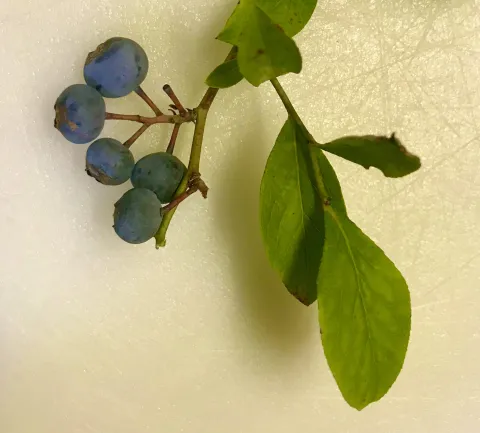Blueberries, a forest treat

A wild blueberry branch
By: Steve Roark
Volunteer Interpreter, Cumberland Gap National Historical Park
Sweet tasting blueberries are a popular food for animals and humans in mid to late summer. Blueberry jam or fresh blueberries on top of some corn flakes is hard to beat.
We have several types of wild blueberries in our area, but they all have similar features. All are shrubs with many branches, with two-inch leaves that are spear shaped, smooth edged, and a short stem. The spring blooming flowers are small, white, and bell-like.
The twigs of blueberries often grow in a zigzag pattern and can be green or reddish in color. The berries themselves are fairly small (pea-sized) and blue when ripe in late July and August. They may be glossy in appearance or look like they have a white powder on them.
The main difference between blueberry species in is height. The high bush blueberry is usually 5 to 10 feet tall and most often found in the higher mountains. The low bush blueberry is only around 3 feet tall and is our most common variety.
There is also the huckleberry looks very similar to the low bush blueberry, but the leaves have small yellowish globs of resin on their lower surface.
Both the blueberry and huckleberry tend to grow where the soil is dry and acidic. Look on ridge tops, south and west facing slopes, and under an oak-pine or oak forest. This is very different to the blueberries of the New England states, which are found in wet, boggy places.
Because blueberries ripen towards the end of summer, they are an important source of food to many species of wildlife that are trying to fatten up for winter. Grouse are especially dependent on the fruit, as well as many songbirds, chipmunk, black bear, skunk and field mice. Rabbits and deer eat the fruit, but also browse on the foliage and branches in winter.
- Log in to post comments